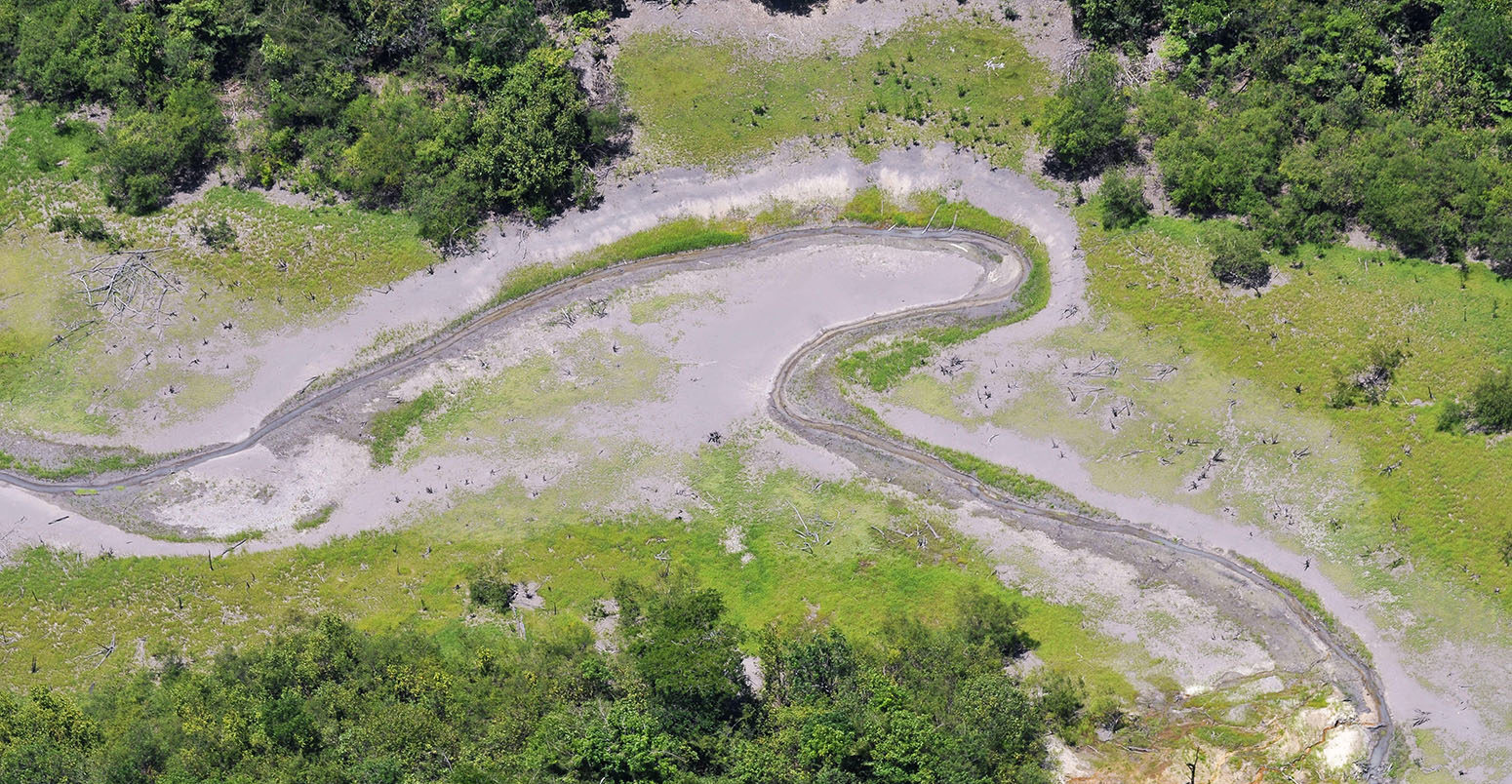
Declining ‘resilience’ pushing Amazon rainforest towards tipping point
Ayesha Tandon
03.07.22Ayesha Tandon
07.03.2022 | 4:00pmThree-quarters of the Amazon rainforest has lost “resilience” since 2003 – making it more vulnerable to extreme events such as droughts – according to new research.
Scientists have long warned that climate change and human-driven deforestation could push the Amazon rainforest past a “tipping point”, which would see the dieback of large sections of lush rainforest and a shift to dry savannah. However, modelling studies have been unable to agree on if and when this threshold might be crossed.
The new study uses observational data to explore how the forest’s “resilience” – a measure of how quickly the forest can recover from a drought or extreme weather event – has changed in recent decades.
The findings, published in Nature Climate Change, suggest that more than three-quarters of the Amazon rainforest has already lost resilience over the past two decades. The drier parts of the Amazon – and regions closer to human land use, such as roads and agricultural lands – are the least resilient, the study says.
These findings add further weight to concerns that the Amazon forest is approaching a “critical threshold” or “tipping point”, the authors say. However, in a press briefing, the lead author stressed that we cannot say when a tipping point might happen based on this analysis.
Amazon resilience
As the largest forest in the world, the Amazon is a huge store of carbon and houses at least 10% of the world’s biodiversity. However, humans are having a well-documented impact on the region through deforestation and climate change.
Last year, the deforestation rate reached their highest level in over a decade – with estimates suggesting that more than 10,000 square kilometres of forest have been lost between August 2020 and July 2021. And, as the climate warms, the moist atmosphere in the Amazon is drying out, leaving the forest more vulnerable to droughts and fires.
Both of these factors are reducing the Amazon’s “resilience” – by making the forest slower to recover from extreme events such as droughts.
The Amazon’s loss of resilience has long been a point of concern for scientists. Many modelling studies suggest that deforestation and climate change-driven drying could cause a further loss of resilience over the coming century. However, identifying how much resilience has already been lost can be tricky.
Rather than relying on climate models, this study uses satellite measurements of the Amazon to determine how much resilience the forest has already lost. The authors assess “vegetation optical depth” (VOD) – a measure of how much biomass is in the plants, which is closely related to water content.
The authors divide the Amazon rainforest into grid cells, using data from the MODIS satellite to select only green areas of forest that have not already been cleared.
They then assess how VOD evolved in each grid cell over 1991-2016. The map below shows the overall change in VOD, where red shows a decrease in VOD (indicating a loss of biomass) and blue shows an increase in VOD.
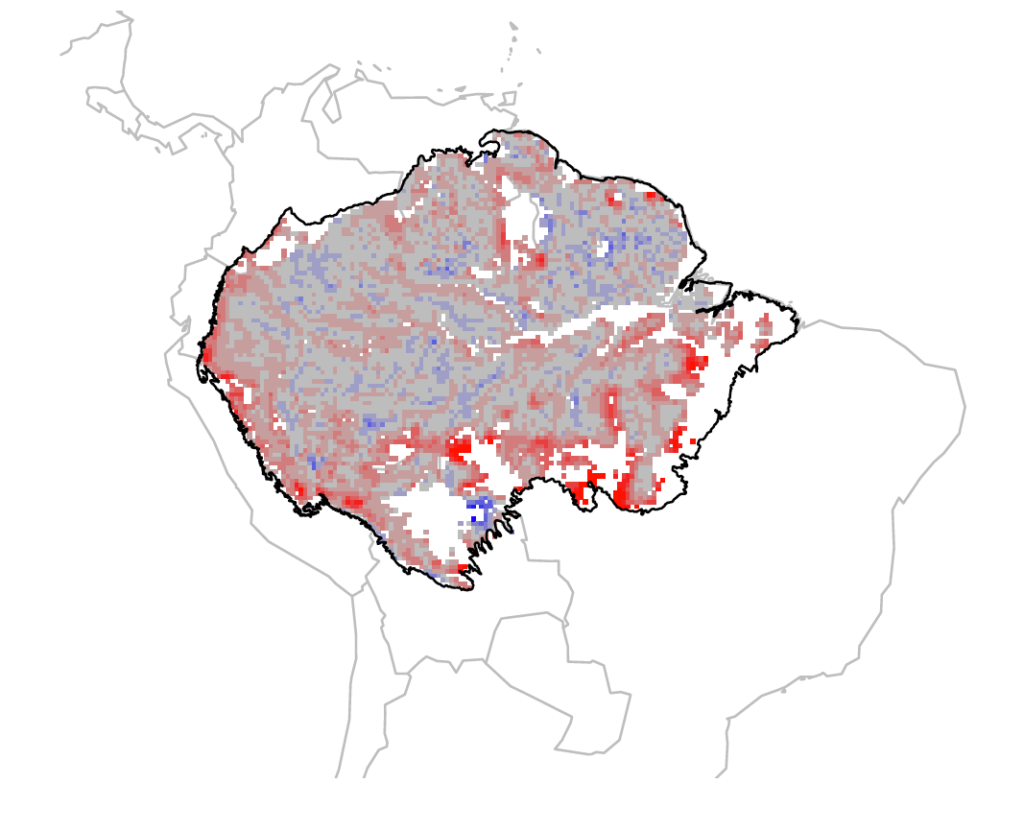
The map shows that overall, VOD decreased over the study period – with the most notable decrease seen in the south-eastern parts of the Amazon basin, along parts of the Amazon river and in some northern areas.
Equilibrium
By assessing incremental changes in VOD over 1991-2016, the authors were able to see how quickly the forest recovers from extreme events such as droughts – and from this determine how its resilience changed.
Dr Chris Boulton – a researcher at the University of Exeter and lead author on the paper – tells Carbon Brief that visualising a ball in a bowl provides a good analogy for the resilience of the Amazon
When the ball is sitting at the bottom of the bowl, he explains, the ball is in its “equilibrium state” – just as the Amazon has its own equilibrium. And the ball is pushed up the sides of the bowl, it will roll back to the centre. Similarly, if the Amazon experiences an extreme event such as a drought that pushes it away from its equilibrium, it will return to its equilibrium.
The faster the ball returns to the bottom of the bowl, the more stable or “resilient” the system is, Boulton explains. The Amazon losing resilience is like the walls of the bowl getting “shallower”, causing the ball to roll back to the centre of the bowl more slowly, he adds. This way of evaluating a loss of resilience is called “critical slowing down” theory, Boulton tells Carbon Brief.
Prof Tim Lenton is the director of the University of Exeter’s Global Systems Institute and an author on the study. In a press briefing, he told journalists that this method of calculating resilience allows scientists to “pick that signal up without it necessarily showing up as a massive change in the biomass or tree cover of the forest”.
Using this method, the authors find that 76% of the Amazon grid cells showed a decrease in resilience from the early 2000s onwards.
Human influence on the Amazon
The study also investigates what is causing the Amazon to lose resilience, by comparing the change in Amazon resilience over time with changes in rainfall and deforestation.
To plot Amazon resilience, the authors use a statistical method that compares the VOD of each month with that of the previous month, to see how much it has changed. This approach gives a resilience score (“AR(1)”), where higher numbers mean lower Amazon resilience, and vice versa.
To assess changes in rainfall, the authors focus on sea surface temperature (SST) changes in the North Atlantic ocean. Warmer SSTs drive a northward shift of the tropical rain belt known as the “Intertropical Convergence Zone”, the study says, which results in drier conditions in the Amazon.
In the plot below, the top panel shows SSTs, where higher temperatures indicate drier conditions. The middle panel shows the resilience score, where higher values indicate lower Amazon resilience. And the bottom panel shows human land use in the Amazon over time, where higher values indicate higher levels of deforestation.
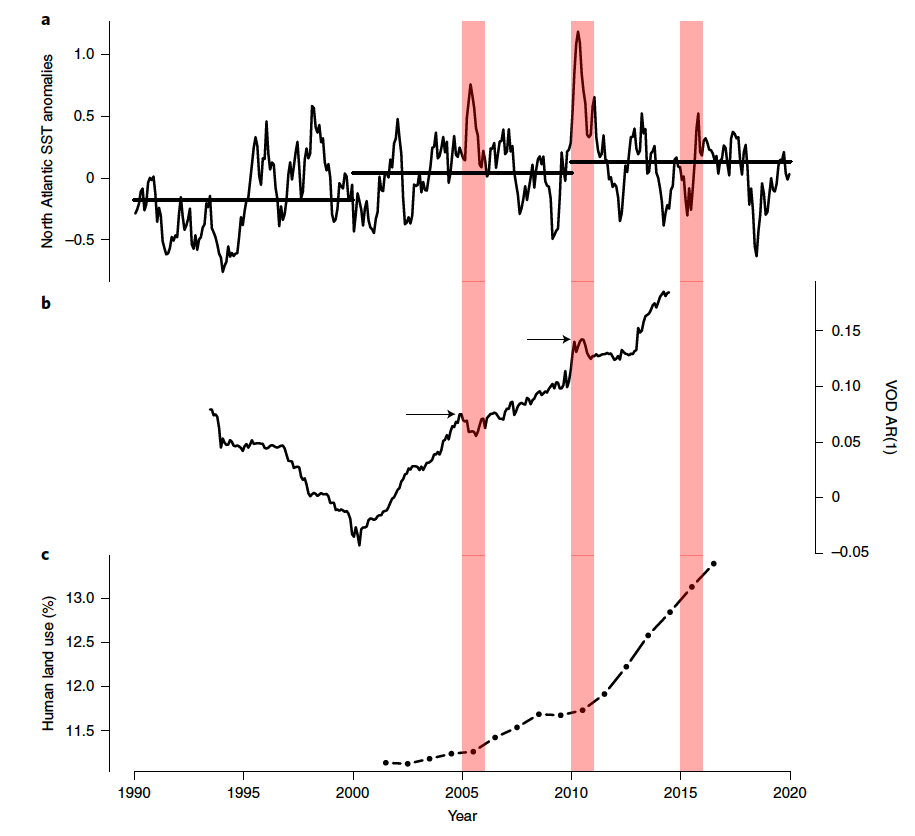
In the plot, the authors have highlighted notable droughts that were caused by high SSTs in red. The paper points to the Amazon droughts of 2005 and 2010, in particular, showing that they were both linked to a clear drop in Amazon resilience.
There is also a clear trend between deforestation and Amazon resilience – with the bottom two panels showing that a rise in human land use was clearly linked to a drop in Amazon resilience.
Land use and rainfall
To look at human land use and rainfall in more detail, the authors assessed how Amazon resilience changed over 1996-2016 for grid cells with different rainfall levels and at different distances from human land use.
In the plot below, the dotted line shows the year 2003, after which resilience decreases notably. In the top plot, the purple line indicates grid cells that are close to human land use, while yellow indicates cells that are far from human land use. In the bottom plot, purple indicates grid cells that saw low levels of rainfall, while yellow indicates grid cells that saw high levels of rainfall.
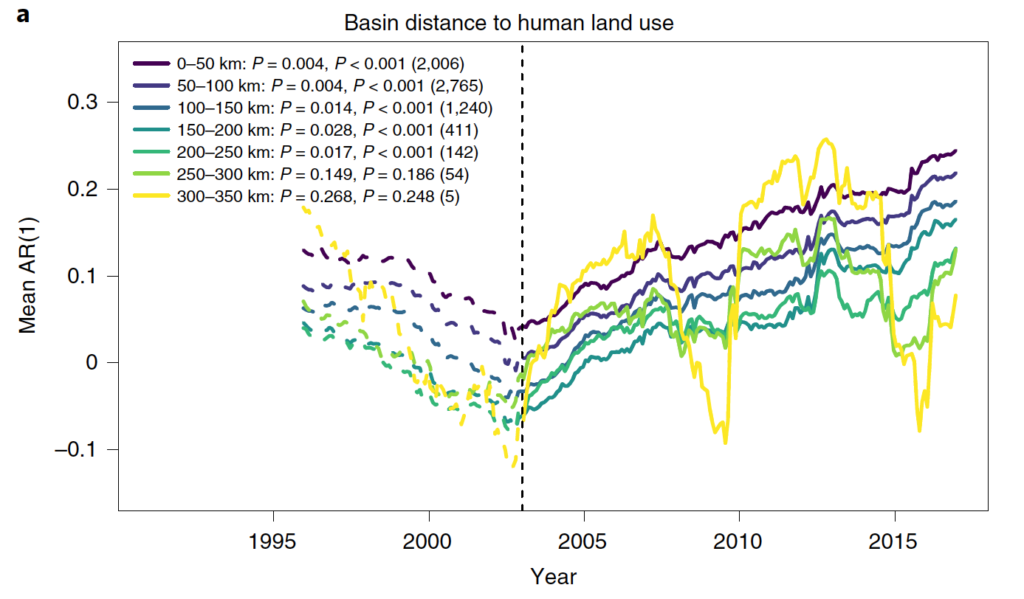
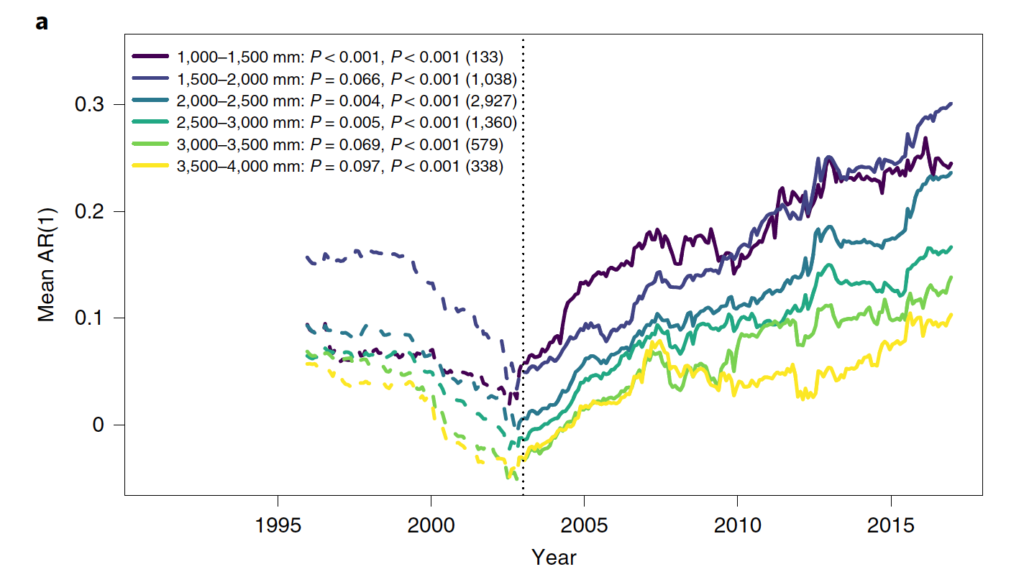
The plots show a clear loss of resilience after the year 2003. They also show that regions with less rainfall, and which are closer to human land use, such as agricultural lands, generally lose resilience more quickly.
The authors also included a separate piece of analysis showing the distance to roads in Brazil, again showing the areas of forest closer to the roads are likely to lose resilience more quickly.
Dr Chantelle Burton, who is from the UK Met Office and not involved in the paper, tells Carbon Brief that this study is “really important” and uses “robust statistical methods”.
However, Dr David Lapola – a researcher at the University of Campinas in Brazil, who was not involved in the study – adds a word of caution about its use of VOD for assessing resilience. He tells Carbon Brief:
“I think it might be an oversimplification to rely our understanding of the resilience of the forest on the amount of leaves or the greenness of the forest vegetation…We cannot forget that a tree is more than leaves, branches and a trunk. There is a whole, largely unknown world below ground, where roots thrive and where water, nutrients and other relations take place and might influence the resilience of the forest.”
Tipping points
Scientists have long worries that climate change and deforestation could push the Amazon rainforest past a “tipping point”. In a Carbon Brief special week of content in 2020 about tipping points, Prof Peter Cox from the University of Exeter wrote a guest post about Amazon dieback, in which he said:
“The Amazon rainforest sustains its own climate by recycling water to the atmosphere, which maintains rainfall and reduces the length of dry seasons. Deforestation undermines those regulatory mechanisms and may, ultimately, lead to a tipping point.
“This, in combination with the dry season becoming long enough to permit regular natural fires, could see the forest transition to a permanent savannah. This would be characterised by a mixed tree and grassland system with an open canopy that allows the soil to become much hotter and drier, as well as store much less carbon.”
In the press briefing, Boulton told journalists that the study shows we are “approaching a tipping point”. However, he stressed, the authors “can’t say when that’s going to happen” based on this analysis.
While many modelling studies have been conducted on the Amazon rainforest, Dr Chris Jones – a scientist at the UK Met Office who was not involved in the study – says that to the best of his knowledge, the critical slowing down method has not been used on observations of the Amazon in this way before. He adds:
“This research adds compelling evidence that climate change is a risk now, and these severe and irreversible impacts could become a reality. We have a narrow window of opportunity to take urgent action.”
Burton adds:
“Passing a tipping point of this kind would make it even more difficult to achieve our goal of net-zero emissions globally because of the loss of the ‘free service’ provided by the Amazon carbon sink which currently removes some of our emissions.”
Boulton et al (2022), Pronounced loss of Amazon rainforest resilience since the early 2000s, Nature Climate Change, doi:10.1038/s41558-022-01287-8

